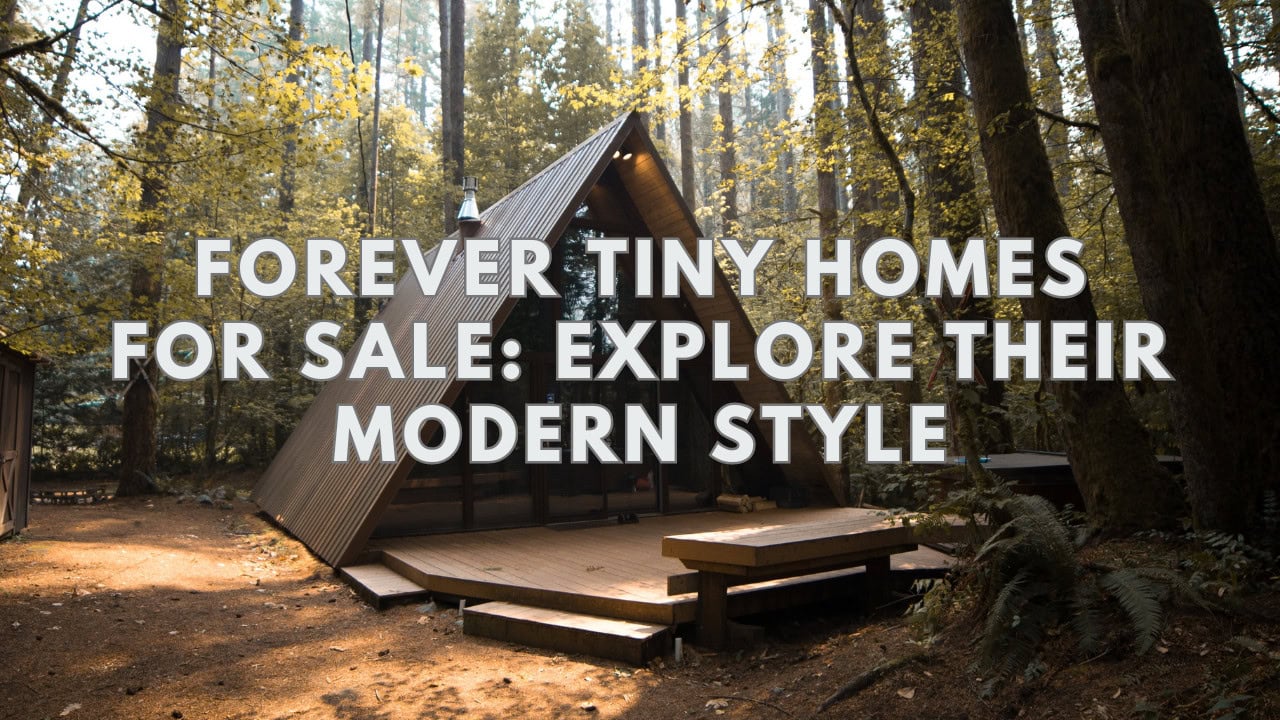Are you considering building a tiny house? One crucial aspect to consider is the selection of windows. With limited space, maximizing natural light is essential. Discovering the perfect tiny house windows can enhance the overall aesthetics and functionality of your dream home. Whether you prioritize energy efficiency, durability, or customization options.
Many alternatives are available in terms of price, design, and material. However, this article will guide you in choosing the right option to create a cozy and inviting living space.
The Design Elements You Should Consider for the Windows in Your Tiny House
Proportion
Consider each room’s elevation while choosing the ideal window height. A tiny home window that has too much space above it might make a room appear smaller, but a room that has too little space can appear out of scale.
Balance
Your tiny house should not have a pair of windows on the opposite side and five windows on the left. To achieve balance in your window design, it is critical to maintain consistency in the size, quantity, and symmetry of your windows.
Symmetry
Make an imaginary line run down the middle axis of your RV home to achieve symmetry in the window design.
Types of Best Windows for Your Tiny House

Awning
Awning windows have a top hinge that allows them to extend outward.
Pros:
- When you want to leave the window open but do not want to stress about rain.
- They are helpful in lofts since you can let fresh air in while you sleep through them.
- They are more affordable than other varieties of windows.
Cons:
- Unless awning windows are mounted high on the wall, as in your loft, they offer little airflow.
- Awning windows stick out from the exterior when they are open. If they are positioned at head height, it could be difficult to navigate your tiny house outside if they are there.
Casement
On one side of the window frame, they have hinges. In addition, installing one of these close to the kitchen would make it easier to handle smoke, odors, and other issues.
Pros:
- Typical casement windows are simple to construct and reasonably priced.
- Excellent airflow from only one direction indicates that the open window will direct the air inside if the wind blows at the right angle.
Cons:
- If the wind is coming from the wrong direction, it is bad for airflow.
- It is advised to install safety catches to ensure a tight seal when the window is closed; this is particularly helpful during the winter.
- When open, a casement window may present a barrier.
Double Hung (Double Sash) Windows
Because these are the most widely used windows, economies of scale are realized. It indicates that these windows will function well and may be found for fairly reasonable prices. You should also consider the material they are constructed of and how simple it is to clean them.
Pros:
- Double-hung windows operate at the top of the frame, which allows for excellent airflow. It is particularly crucial for removing moisture and hot air from small places. Therefore, these windows are an excellent option for high ceilings at the top of your pitch or bathrooms inside.
Cons:
- Double windows can be more costly than other window types since they require more time to manufacture because both sashes must move.
- Fly screens are typically found outside the window.
- Cleaning the window requires removing the exterior fly screen from the outside, which might be challenging if the opening is high enough.
- When moving your tiny home on wheels, it’s best to remove exterior fly screens from the windows since wind and vibration from the road could cause them to come free.
Fixed Picture

These are an excellent, reasonably priced way to let in light. You can save a significant amount of cash because they are less complex. After all, they are not operable.
Pros:
- The least expensive windows are those that are fixed.
- Ideal for highlighting windows that showcase unusual shapes or vibrant glass colors.
- Since you do not depend on seals, there is no air leakage.
Cons:
- Do not open; thus, do not allow for any airflow.
Slider Windows
They are from two glass pans. The additional door moves across the fixed one to open.
Pros:
- They are ideal for little spaces in your mini home because they can be made compact.
- Without using a mechanical extraction fan, you can passively release moisture from your shower by finding a frosted slider window in your bathroom stall.
Cons:
- A slider window’s ability to open completely is frequently limited, which reduces ventilation.
- With frequent use, slides can gather dirt and grime that might be difficult to clean.
Bay Windows
You can create the illusion of more space in your living room or bedroom by adding warmth and light to the interior of your house. Compared to other window styles, tiny house bay windows offer space because of their concave shape.
Pros:
- They raise your house’s worth. Many adore the appearance of bay windows. All that glass gives off a crisp, contemporary vibe when you factor in the extra square footage.
Cons:
- Finding window treatments is not easy. Hardware for blinds, curtains, and other treatments is frequently challenging to install because of the angles and shapes of bay windows.
Center Pivot Windows
The entire window pivots, enabling it to be positioned horizontally to the frame. The vertically hanging glass has an opening on both sides due to a central pivot window.
Pros:
- For a little dwelling, center pivot windows offer the finest airflow. When this type of window is used, even small windows can provide excellent ventilation. It is a result of your little house’s open window, which directs wind in both directions.
Cons:
- There must be an awning covering the highest point of the center pivot window.
Tiny House Window Materials
Achieving the ideal material for your windows requires striking a balance between appearance, cost, and care.
Vinyl Windows Frames
Pros:
- Little upkeep
- Low price
- Effective heat protection
Cons:
- Not painful
- Fortitude
- Both growth and shrinkage
Wood Windows Frames
Pros:
- Naturally scented, wooden frames can smell wonderful.
- Able to be obtained sustainably
- Some woodlands may be relatively bright.
- Window frames made of wood can be fixed
- Finishing arches is simple.
Cons:
- Certain timbers can weigh a lot.
- Since wooden window frames are larger than aluminum ones, they occupy a larger area in the rough opening, which reduces the space available for pane windows.
- The easiest way to maintain wood is to give it sporadic coats of oil or paint.
Aluminum Windows Frames
Pros:
- Fortitude
- Color selections
- little upkeep
- Resiliency
Cons:
- Quality differs.
- Poor heat efficiency
- Problems with the thermal barrier
Clad Wood Windows
Pros:
- Minimal upkeep required outside
- Color selections
- Paintable and stainable interior
- The actual wood’s appearance and feel
- Hardware options
Cons:
- High price
- Absence of external details
- Interior upkeep
- Quality can differ
Steel Windows
Pros:
- Fortitude
- Limited sight lines
- Color selections
- Resiliency
Cons:
- It is cold
- Retail appearance
- High price
Tiny House Window Glass Types

Tempered Glass
Similar to a glass shower door or your car’s windshield, this is safety glass. When heat is applied, it becomes significantly solid and, if it breaks, fragments into tiny pieces rather than massive shards that may lacerate deep wounds.
Laminated Glass
Laminated glass is simply multiple pieces of glass sandwiched together with sheets of clear vinyl.
With these windows, you also have enhanced security, so you might think about investing the extra cash in glazing over your front door, which is a potential entry point for burglars.
Plexiglass Windows
The primary cause is that a conventional window has two panes sealed together with a gas in between. That offers a significant benefit in terms of condensation reduction and insulating value. There is no method to seal two pieces of plexiglass, produce a vacuum, fill it with a more appropriate gas, and then build a durable seal if you make your windows out of plexiglass.
FAQs
Can A Tiny House Declutter Your Life?
Do you ever feel as though you have a lot of stuff? Moving into a little place causes you to purge your belongings, which is a tremendous benefit. Furthermore, when you declutter your mind and life, you won’t be able to gather as much stuff because there won’t be enough room for it all. Consider how much cash you will save by avoiding souvenirs and trinkets at random. Living in a tiny place means having just what you need to get by each day.
What Are the Ideal Windows for Your Tiny Home?
The ideal windows for your tiny home will be energy-efficiently certified and provide lots of natural light. To determine how big of a window you can fairly incorporate into the design, measure the dimensions of your tiny house and the accessible wall space in each room. Although bigger is not always better, the design should be open and let in natural light for the best airflow.
How to Pick Windows for a Tiny House
There are quite a few significant factors when it comes to windows. Price, custom vs. stock, and design are the main factors here. Because they take a long time to arrive, the main decisions you make should be made early. While handmade windows can take between thirty and sixty days to arrive, buying standard windows may only take a few weeks.
The cost will heavily influence your decision. Simply put, you will be able to purchase custom windows, or you won’t have any choice but to settle for stock. Beyond that, you should pick a style that complements your design.
Wrap-Up
Tiny house windows are a great opportunity to show off your individuality and sense of style, in addition to letting in light and air. You may customize your small house windows to fit your needs and tastes with several alternatives, including wood or vinyl, awning or casement windows, and custom or stock windows.
If you pick the appropriate kind, size, and location for your tiny house windows, you may also improve the beauty, comfort, and energy efficiency of your tiny home because they are an essential component of living in a small space; they are more than just wall apertures.





